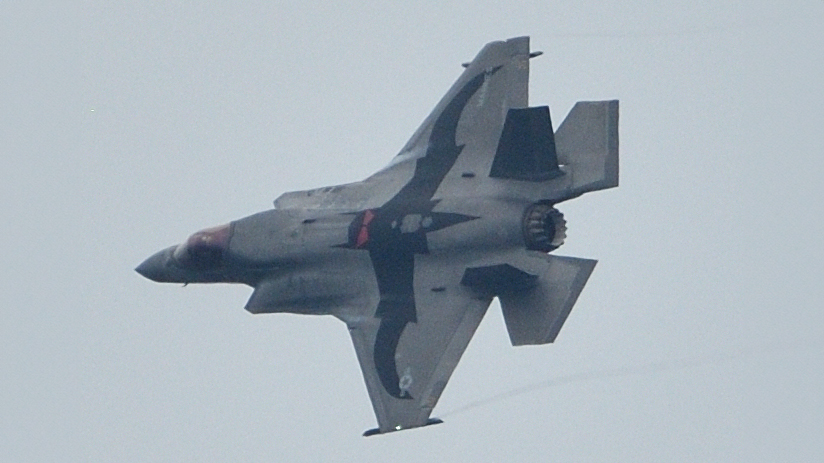The commander of Marine Fighter Attack Squadron 242 at MCAS Iwakuni, Japan, now has the bat from the unit’s insignia stenciled over the top of the fuselage and wings of his F-35, in addition to the colored markings.
An F-35B of the United States Marine Corps’ Marine Fighter Attack Squadron (VMFA) 242 “Bats” us now flying with a large bat stenciled over the top of its fuselage and wings. The bat with red eyes comes directly from the unit’s insignia and recently made its debut on the commander’s aircraft.
The aircraft, Modex DT-01, was scheduled to fly for the first time with the giant bat markings on Jun. 11, 2024, after being sighted in flight for the last time in May 2023, according to local photographers. The photos released by the USMC confirm that the aircraft flew indeed on June 11, displaying the bat insignia for a special occasion.
June 11,2024 MCAS IWAKUNI
VMFA-242 DT Bats 01
背中に大きなコウモリが描かれているのを確認しますた(^^) pic.twitter.com/e3vWzrgAvS
— 銀次 (@wwBIOSww) June 11, 2024
In fact, the aircraft was flown by the outgoing commanding officer of VMFA 242, Lt. Col. Alexander Mellman, who took the F-35B for a final flight at the end of a 20-year career. The commander’s aircraft already had colored insignias for years, but the bat only appeared on the aircraft before the fini-flight.
今の岩国ではこれが限界(・・;
オーバーヘッドアプローチ後に左旋回するところを狙いました。当然ながら遠いですが、鬼トリミングで背中を見ることが出来ました。 pic.twitter.com/4WTroA1U3s
— 銀次 (@wwBIOSww) June 20, 2024
JUN/20/2024 Iwakuni#岩国基地
2ndで背中リベンジです pic.twitter.com/ngLv6B3mIk
— jibitz (@jd921858) June 20, 2024
In the days following the debut of the giant bat, the aircraft has immediately become an attraction among local aviation photographers trying to get a better look at this F-35B. Among these was @wwBIOSww on X, a Japanese photographer who kindly allowed us to repost his photo here at The Aviationist.
This aircraft, in fact, is the first instance, to our knowledge, of F-35s with topside special markings. Many F-35s in the United States, usually flagship aircraft used as the commanders’ aircraft, are already using colored markings and insignias instead of the standard low-visibility ones, however we have never seen anything like VMFA 242’s bat.
Initially, it was almost impossible to see anything colored on the Lightning II, but things are now changing. In fact, as we often reported, there are now F-35s with special liveries assigned to the U.S. Air Force 65th Aggressor Squadron, as well as flagship aircraft with colored unit insignias in the Navy and Marine Corps and aircraft with colored national insignias in Europe. Also, let’s not forget the mirror coating that was spotted on some F-35Cs.
JUN/20/2024 Iwakuni#岩国基地
背中が好物なこの季節 pic.twitter.com/xu78pYFen4
— jibitz (@jd921858) June 20, 2024
The “limitation” was mainly due to the fact that, to preserve the low observability (LO), the adopted paint scheme should be made of a combination of colors approved for use on the F-35. In 2022, just 6 Federal Standard Paint colors were approved for use on the type, as the LO coating is one of the aircraft’s most delicate components.
Marine Fighter Attack Squadron (VMFA) 242
MCAS (Marine Corps Air Station) Iwakuni, Japan, is the first air base where the F-35 Lightning II was deployed outside of CONUS (Continental US), with Marine Fighter Attack Squadron (VMFA) 121 relocating there in 2017. VMFA 242 was already permanently based at Iwakuni, although it converted from the F/A-18 Hornet to the F-35B only in 2020.
The unit declared the Initial Operational Capability in October 2010, just 10 months after beginning the transition from the F/A-18 to the F-35B. A month later, two of its F-35Bs deployed on the Japanese aircraft carrier JS Izumo, after the completion of the first part of the modifications required for the conversion from helicopter carrier to light aircraft carrier.
JUN/20/2024 Iwakuni#岩国基地
鬼トリ😅 pic.twitter.com/4EVQ8JG88V
— jibitz (@jd921858) June 20, 2024
The F-35s became the first fixed-wing aircraft to operate from a Japanese ship since WW2, while the Izumo became the country’s first aircraft carrier since WW2. The Japan Maritime Self-Defense Force requested the collaboration of the United States to verify that the F-35B can safely perform flight operations from the JS Izumo’s flight deck, before work resumed for the second round of modifications.
The USMC and the F-35B
The US Marine Corps are currently undergoing a major transformation from the legacy AV-8B Harrier II “Jump Jet” tactical aircraft to the F-35B Lightning II. During the past few years, the Marine Corps have been activating F-35B squadrons and deactivating Harrier squadrons and, at the moment, the Marines are down to two remaining Harrier squadrons.
The F-35B performed the first ever US combat mission ever of the Joint Strike Fighter on Sept. 27, 2018. Marine Fighter Attack Squadron 211, the “Wake Island Avengers”, used their F-35B Lighting II jets to hit insurgent targets in Afghanistan during long-range strikes launched from the U.S. Navy Wasp-class amphibious assault ship USS Essex (LHD-2) on station in the Persian Gulf.
JUN/20/2024 Iwakuni#岩国基地
背中のコウモリ🦇
私にはこれが限界… pic.twitter.com/04e6NP8d2B
— jibitz (@jd921858) June 20, 2024
The U.S. Marine Corps was the first military service in the world to integrate the F-35 Joint Strike Fighter into operational service during 2015. The F-35B Lightning II is perhaps the most complex variant of the 5th gen fighter, which uses an innovative vectored thrust and lift-fan configuration to take off from a ship’s flight deck without a catapult in a short distance and land back on board vertically from a hover.
Compared to the F-35A, the B variant is equipped with an externally mounted GAU-22 25 mm gun pod, in addition to the weapons in the internal bays. The B variant also has slight smaller weapon bays, which restricts the choice of the heaviest load that can be carried internally. These shortcomings, however, are compensated by the flexibility of the platform, which can operate from almost anywhere, allowing to perform dispersed operations from austere locations.













